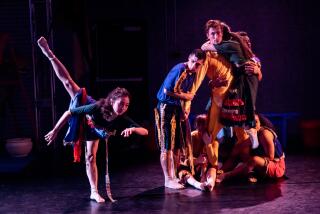High steps, on the steppes of Cerritos
- Share via
Fifty years after its American debut and three months after the death of its founder, the Moiseyev Dance Company on Friday verified its credentials as the world’s premier folk ensemble at the Cerritos Center for the Performing Arts.
No kick lower than shoulder height, no backbend unless the head brushed the floor: Moiseyev technique looked positively awesome in this relatively intimate theater, where every detail of costume or choreography seemed spotlighted.
And this time, the company earned its standing ovations without its best loved repertory -- the Ukrainian hopak, for instance, with a man flying over a line of women. Or “Partisans,” Igor Moiseyev’s tribute to World War II freedom fighters. Or “Old City Quadrilles,” his alternately satiric and nostalgic depiction of Moscow social dancing way back when.
Instead, the showstoppers were often the same pieces the company danced at the Hollywood Bowl three years ago. Oleg Chernasov again took the audience by surprise with a trick solo that disguised him as two interlocked Nanayan child-wrestlers. The Bessarabian Gypsy Dance once more started in exotic languor and accelerated into wild flamboyance. The Moldavian suite, as always, deployed two dozen dancers in geometric formations that only ceased to evolve when they became the backdrop for high-speed virtuosity by smaller cadres.
However, the Cerritos audience also couldn’t get enough of Alexander Tikhonov, Dmitry Klokotov and Rudiy Khodzhoyan in their Argentine gaucho solos: spurs jingling as they stamped through step patterns ornamented with gestures depicting the riding of horses.
Another work ending in an encore: the Sirtaki line dances, with the performers far too perfectly matched in timing, leg height and so on to look like ordinary Greeks at a party (where the unisons would be approximate and individual), but certainly exemplary in technical control.
Many of the smaller-scale Slavic pieces on the 11-part program held the greatest choreographic interest because of their distinctive vocabularies. In the dead-serious Kalmuk trio, for example, Ramil Mekhdiev, Evgeny Chernyshkov and Yuri Chernyshkov developed gestural themes suggesting the fluttering of wings. Anna Shchukina and Nikolay Rubtsov’s duet in the large-scale “Russian Dance Summer” had a courtly delicacy and reserve, a quality that also sweetened the early sections of “Polyanka.”
It didn’t last long, of course, for Moiseyev almost always used mellowness and charm as a prelude to in-your-face bravura -- in “Polyanka,” sharp turns for the six women and squat kicks for the six men. But the breezy “Tatarochka” (a North American premiere on this tour) did stay small, light and deft throughout, with running steps for Olga Volina -- forward and backward -- leading to attempts by Dmitry Klokotov and Oleg Chernasov to keep up with her.
In contrast, Moiseyev’s “Polovetsian Dances” enlisted the entire company in a pseudo-primitive Tatar divertissement from the Borodin opera “Prince Igor,” with the dancers divided into pretty much the same groups (slaves, boys, archers, spearmen, etc.) as in the well-known 1909 version by Mikhail Fokine and, before that, one by Lev Ivanov.
Unfortunately, the piece suffered from the crudely reorchestrated taped accompaniment -- with some weird tempos for the women’s dances -- and looked cramped on the Cerritos stage. Yes, the warriors jumped thrillingly, bared chests gleaming in the light of the steppes. But for military spit and polish, their fierce swagger couldn’t compete with the parade-ground exactitude of “Yablotchko,” an excerpt from a naval suite featuring wave after wave of sailors executing intricate, high-velocity footwork, including hornpipe steps.
The program began with an uncredited short film summarizing Moiseyev’s life, including rare footage dating back to the 1930s. “We want to leave a mark on history,” he said to his dancers at one point, and the current company -- no less than the film -- showed how much he changed everyone’s expectations about what kinds of dance could be exciting in the theater.
--
More to Read
The biggest entertainment stories
Get our big stories about Hollywood, film, television, music, arts, culture and more right in your inbox as soon as they publish.
You may occasionally receive promotional content from the Los Angeles Times.










